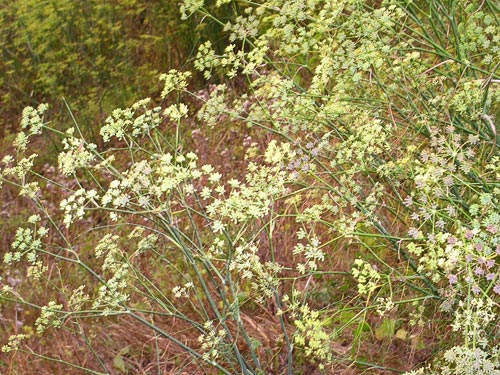Relatives
Foeniculum vulgare Mill. - Common fennel.
Taxonomic position.
Family: Apiaceae (Umbelliferae Moris.); genus: Foeniculum L.Morphology and biology.
Perennial or biennial plant. Root is fusiform, up to 1 cm thick, branchy in the upper part, polycephalous. Stem is straight, 90-200 cm high, round in cross-section, finely costate, abundantly branching. Leaves are ovate-triangular in shape, tri- or quadripinnatisect; lower ones are stalked, upper ones are sessile on a broadened sheath; ultimate lobes are thin, filiform, acuminate on top, cartilaginous. Leaf sheaths are 3-6 cm long, narrow-oblong, filmy along the edges, slightly widened towards the top and pulled back in a hood-like manner. Umbels with 3-20 (25) unequal naked rays are 3-15 cm in diameter. Swathe and involucel are absent. Leaflets are broadly ovate, yellow, about 1 mm long and almost equally wide. Fruit have oblong ovoid shape, 5-10 mm in length and 2-3 mm in width. Blossoms in July, bears fruit in August/September.Distribution.
Worldwide distribution: Atlantic and Central Europe; Mediterranean region; the Balkans and Asia Minor; Iran; Northern and Southern Africa. Ecdemic in North and South Americas, Japan and China. Within the ex-USSR: European part (Crimea); Caucasus (Ante-Caucasus, Daghestan, Eastern and Western Transcaucasia, Talysh); Middle Asia (Mountainous Turkmenistan and Pamir-Altai region).Ecology.
On maritime stony slopes, rocks and sands along the seacoast.Utilization and economic value.
Since the ancient times fennel has been known as a vegetable, medicinal and spicy crop. It was mentioned by such authors as Theophrast and Dioscoride. Besides, it has been cultivated for essential oil, extractable from fruit by distillation (4-6%). Its major component is anethole. The oil is colourless or yellowish, with a distinctive odour, initially having bitterish taste, later sweetish. Several sorts of fennel oils are recognized: Florentine, Saxon, Indian, etc. Fennel oil is used in soap production and pharmaceutics as well as to produce anethole.References:
Cherepanov, S. K., Plantae Vasculares Rossicae et Civitatum Collimitanearum (in limicis USSR olim). St-Petersburg, "Mir I Semia", 1995, 990 p. (in Russian).Flora USSR, 1950. Vol. XVI. B. K. Shishkin (ed.). M.-L.: Publishing House of the USSR Academy of Sciences, p. 542-545. (in Russian).
Galushko, A.I. 1980. Flora of Northern Caucasia. Manual, Vol. 2. Rostov: Publishing House of Rostov University, p. 266. (in Russian).
Grossgheim, A. A. 1967. Flora of Caucasia. Leningrad, Nauka, Vol. VII, 311 p. (in Russian).


